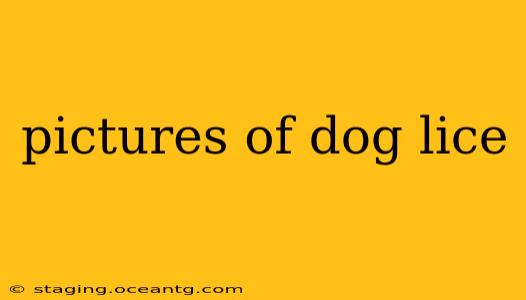Pictures of Dog Lice: Identifying and Treating These Pesky Parasites
Dog lice are tiny, wingless insects that infest dogs, causing intense itching and discomfort. While a picture can be helpful, accurately identifying dog lice requires careful observation and sometimes, professional veterinary assistance. This article will guide you through identifying dog lice through images and descriptions, and discuss treatment options.
What do dog lice look like? (Addressing a common PAA)
Dog lice are small, typically ranging from 1 to 3 millimeters in length. They are usually grayish-white or brownish in color, though their appearance can vary slightly depending on their feeding stage and the species. High-quality images, often found on veterinary websites or in entomological resources (though I can't link directly to them here), will show you the details: their six legs, their flattened bodies, and their relatively slow movement. Unlike fleas, which jump, lice crawl. You’re more likely to find them clinging to the dog's hair shaft. Finding nits (lice eggs) is also crucial for identification. These are small, oval-shaped, and firmly attached to the hair shafts, near the skin. They often appear white or light brown.
How can I find pictures of dog lice online to compare? (Addressing a potential PAA)
Many veterinary websites and online pet resources feature images of dog lice. A simple Google image search for "dog lice" or "dog louse close-up" will reveal various pictures. Be aware that image quality varies, and some images may be better than others for identification purposes. Look for images that clearly show the lice's features, such as their legs and body shape. Comparing your findings with these online images can help in identification, but remember, visual identification is not always definitive.
What are the different types of dog lice? (Addressing a common PAA)
There are two main types of lice that affect dogs: Linognathus setosus (long-nosed dog louse) and Trichodectes canis (dog biting louse). While images may show slight differences, microscopic examination is often necessary for precise identification. Both cause irritation and itching, but Trichodectes canis can also transmit tapeworms.
Are dog lice dangerous to humans? (Addressing a common PAA)
While dog lice primarily infest dogs, they cannot permanently live on humans. They may briefly try to bite a human, causing minor irritation, but they cannot complete their life cycle on us. So, while not dangerous in the sense of transmitting serious diseases to humans, they can cause temporary discomfort.
What should I do if I think my dog has lice?
If you suspect your dog has lice, it’s essential to consult a veterinarian. A vet can accurately diagnose the infestation, confirm the type of louse, and recommend the most effective treatment. Self-treating can be ineffective and may even harm your pet. Veterinarians typically prescribe medicated shampoos, sprays, or dips specifically designed to kill lice and their eggs. Thorough cleaning of the dog's bedding and environment is crucial to prevent re-infestation.
How can I prevent dog lice infestations? (Addressing a common PAA)
Preventing dog lice infestations involves good hygiene practices. Regularly grooming your dog, checking its coat for parasites, and keeping its environment clean are vital preventative steps. If you have multiple dogs, separating them can limit the spread of lice. Using a preventative topical treatment as advised by your veterinarian can also help to mitigate the risk.
Disclaimer: This information is for educational purposes only and does not constitute veterinary advice. Always consult a veterinarian for any health concerns related to your pet. While images can help in identifying dog lice, professional diagnosis is always recommended.
